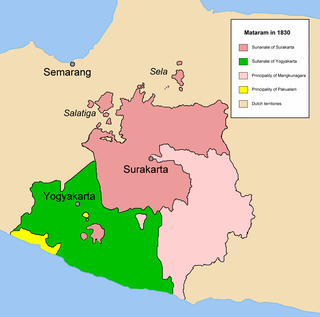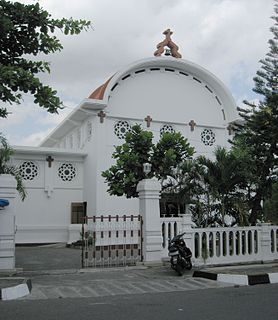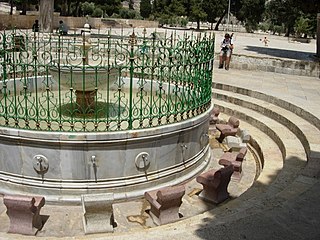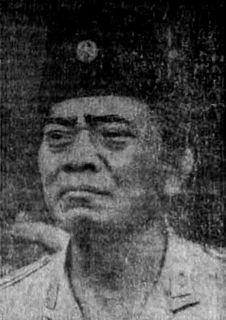
The kris is an asymmetrical dagger with distinctive blade-patterning achieved through alternating laminations of iron and nickelous iron (pamor). Kris is most strongly associated with the culture of Indonesia. The kris is famous for its distinctive wavy blade, although many have straight blades as well.

The Java War or Diponegoro War was fought in central Java from 1825 to 1830, between the colonial Dutch Empire and native Javanese rebels. It started as a rebellion led by Prince Diponegoro, a leading member of the Javanese aristocracy who had previously cooperated with the Dutch.

Sri Sultan Hamengkubuwono X is the Sultan of the historic Yogyakarta Sultanate in Indonesia, and is currently also the Governor of the modern Yogyakarta Special Region.

Hamengkubuwono IX or HB IX; 12 April 1912 – 2 October 1988) was the first Governor of the Special Region of Yogyakarta, the second Vice President of Indonesia and the ninth Sultan of Yogyakarta during the rule of Suharto.

Raden Saleh Sjarif Boestaman was a pioneering Indonesian Romantic painter of Arab-Javanese ethnicity. He was considered to be the first "modern" artist from Indonesia, and his paintings corresponded with nineteenth-century romanticism which was popular in Europe at the time. He also expressed his cultural roots and inventiveness in his work.

Taman Mini Indonesia Indah (TMII) or "Beautiful Indonesia Miniature Park" is a culture-based recreational area located in East Jakarta, Indonesia. It has an area of about 250 acres (1.0 km2). The park is a synopsis of Indonesian culture, with virtually all aspects of daily life in Indonesia's 26 provinces encapsulated in separate pavilions with the collections of rumah adat as the example of Indonesian vernacular architecture, clothing, dances and traditions are all depicted impeccably. Apart from that, there is a lake with a miniature of the archipelago in the middle of it, cable cars, museums, Keong Emas Imax cinema, a theater called the Theatre of My Homeland and other recreational facilities which make TMII one of the most popular tourist destinations in the city.

Yogyakarta Sultanate is a Javanese monarchy in Yogyakarta Special Region, Indonesia. The current head of the Sultanate is Hamengkubuwono X.

Kedu Plain, also known as Progo River valley, is the fertile volcanic plain that lies between the volcanoes, Mount Sumbing and Mount Sundoro to the west, and Mount Merbabu and Mount Merapi to the east, roughly corresponds to present-day Magelang and Temanggung Regency of Central Java, Indonesia.

Plered was the location of the palace of Amangkurat I of Mataram. Amangkurat moved the capital there from the nearby Karta in 1647. During the Trunajaya rebellion, the capital was occupied and sacked by the rebels, and Amangkurat died during the retreat from the capital. His son and successor Amangkurat II later moved the capital to Kartasura. It was twice occupied by Diponegoro, during the Java War (1825–1830) between his forces and the Dutch. The Dutch assaulted the walled complex in June 1826, which was Diponegoro's first major defeat in the war.

Duchy of Pakualaman or simply Pakualaman is a minor Javanese princely state within the Sultanate of Yogyakarta. It was created in 1812 when Natakusuma was rewarded for helping the British quell the conflict in Yogyakarta in June 1812. It became the mirror-image of the Mangkunegaran principality in the territory of the Susuhunanate of Surakarta.

The Kraton Ngayogyakarta Hadiningrat is a palace complex in the city of Yogyakarta, Yogyakarta Special Region, Indonesia. It is the seat of the reigning Sultan of Yogyakarta and his family. The complex is a center of Javanese culture, and contains a museum displaying royal artifacts. It is guarded by the Yogyakarta Kraton Guards.

Taman Sari Water Castle, also known as Taman Sari, is the site of a former royal garden of the Sultanate of Yogyakarta. It is located about 2 km south within the grounds of the Kraton, Yogyakarta, Indonesia. Built in the mid-18th century, the Taman Sari had multiple functions, such as a resting area, a workshop, a meditation area, a defense area, and a hiding place.

Surakarta Sunanate is a Javanese monarchy centred in the city of Surakarta, in the province of Central Java, Indonesia.

Dharma Wiratama Museum, officially the Dharma Wiratama Central Army Museum is a military museum centred on the history of the Indonesian Army from its inception in 1945 up through the coup of 30 September 1965 and Indonesian peacekeeping missions. It is located in the former national army headquarters in Yogyakarta.

Bintaran is a district in Yogyakarta, Java, Indonesia. The area is known for its Dutch-Javanese architecture. It was formerly a Catholic settlement.

The Submission of Prince Dipo Negoro to General De Kock is an oil painting on canvas painted by Nicolaas Pieneman between 1830 and 1835. It depicts, from a victorious Dutch colonial perspective, the capture of Prince Diponegoro in 1830, which signaled the end of the Java War (1825–1830).

The Arrest of Pangeran Diponegoro is the name of an 1857 painting by Raden Saleh, depicting the capture of Prince Diponegoro by Lieutenant General Hendrik Merkus de Kock on 28 March 1830.























